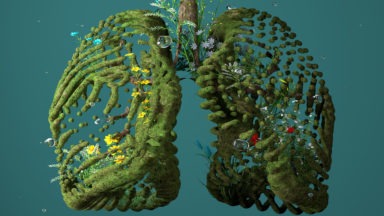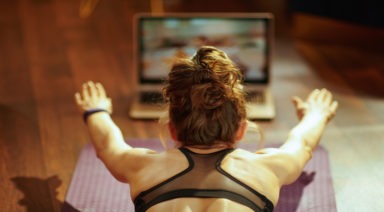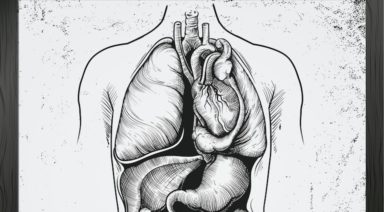Relieve Stress in Less than 45 Seconds

Many years ago I had an 80 year-old friend with advanced ALS. “The Colonel” (as we lovingly called this good-natured retired Army officer) could pull off a maneuver I thought was somewhere just north of a medical miracle and just south of a party trick: he could lower his blood pressure, slow his respiration and calm his heart rate in less than 45 seconds.
Although he had lost control of many bodily functions and was in almost constant physical and mental discomfort, The Colonel was wary of relief promised by pills and potions–he liked to do things the natural way. When it came time to take his vital signs, he would subtly shake his head and say, in a computer-synthesized voice (he had lost his ability to speak years ago, and teased us with his “British aristocratic” or “five year-old kid” vocals): Give me a minute.
From the outside it looked like The Colonel was just sitting there doing nothing–eyes soft and unfocused, breath slow and measured–then, in about 45 seconds, he lifted his gaze, took one last exhale, gave as much of a “nod” as his compromised neuromuscular system would allow, and signaled: Ready. Sure enough, contrary to all medical indications, his heart rate, blood pressure and pulse suddenly measured somewhere in the normal range.
The Colonel had settled his electrified nervous system, slowed his own heart rate, and relaxed his usually anxious mental state in less than a minute–the lowered vital signs “proved” the success of his nifty trick. It also seemed he had magically transformed the environment–the air seemed sweeter, the fluorescent lighting more diffuse–even my own frazzled nerves and reeling mind had taken an unexpected timeout thanks to those few brief seconds. All this without medication, lengthy preparation, or fancy procedures: all he did was sit quietly, focus, and breathe.
You can use a similar technique to keep your own vital signs in check and get some instantaneous stress relief–it takes less than 45 seconds. The secret is inviting your mind to trigger the relaxation response–it’s quick and easy to do! To start, here’s a glimpse behind-the-scenes of how stress works.
How does stress work?
- Stress often feels like a purely emotional or psychological problem; in fact, there are a host of physiological factors involved in stressful, anxious feelings–collectively this is referred to as the fight-or-flight response
- In our fast-paced lives, this reactive strategy (so useful in truly dangerous situations) can get stimulated for all the wrong reasons: cell phone alerts, background noise, lack of sleep, trouble in the workplace, financial concerns, family disagreements, health issues, and more
- Symptoms of an overactivated nervous system can include anxiety, digestive problems, anger or depression, chest pain, panic attacks, sweating, dizziness, muscles soreness, and headaches, to name just a few
- Acute stress is relieved only when the brain receives cues from the body that we are no longer in danger, but actually safe enough to open our clenched fists, slow down our fleeing feet, or move our fear-frozen muscles. If we fail to provide the brain with these cues, we will stay activated and on “high alert” for some life-threatening situation that never comes our way
- Instead, we can signal our brains to prompt the relaxation response with four simple techniques: adjusting our posture, relaxing tensed muscles, slowing the breath rate and deepening our breathing–it all takes under a minute
Learn more about how stress affects your body, including your adrenal glands, here.
Need some instant stress relief after a frustrating work meeting, a long drive home on a snowy road, or while figuring out your annual taxes? Here are four complementary tools that work together to deactivate the stress response in a hurry.
Four Tools to Deactivate Stress in a Hurry
- Adjust your posture. First…stop moving! Cue your brain that you are safe and secure: sit in a comfortable position (instead of tensing to flee); open your palms and turn them upward (instead of clenching to fight); let your eye gaze be soft and unfocused (instead of alerting to danger). If you can, keep your spine upright and energetically connected to the solid ground below your feet and vast expanse above your head. Let your shoulders melt away from your ears and your heart peek forward from your ribcage.
- Relax tense muscles. Where do you normally hold your tension? Shoulders? Lower back? Jaw? Abdomen? Position your body so that specific area can release its rigidity. Next, focus on the sensations arising in that spot, and mentally will that body part to let go and relax. Try sending oxygen from your inbreath directly into the tight places; wiggle or gently knead those muscles if it feels good (that will also help move oxygen into the area). Let your body–along with your worries and cares–melt into the chair, floor, or bed.
- Slow down your breathing. When you are scared, overwhelmed, anxious, or wary, your body is trained to take short, rapid sips of air. To destress, notice your breathing pattern–are you panting, light-headed, hyperventilating? Consciously slow down your breath–it might seem unnatural at first, but just do it! You can count your inhalations or exhalations if helpful. Imagine circulating fresh oxygen throughout your body with the inhale, and squeezing out carbon dioxide all the way from your fingers and toes as you exhale. You can pause slightly at the top of the inhalation and at the bottom of the exhalation–this can also help to slow things down. Remember: we only breathe slowly when we feel safe and secure, so this is an important component of the calming response.
- Deepen your breath. You not only breathe rapidly when anxious or stressed, but your breath pattern moves to the upper chest and gets more shallow. In order to relax, we need to practice breathing like a baby–puffing out the belly on the inhale, and forcing out all the air (pulling the navel to the spine) on the exhale. It takes a bit of practice to feel comfortable belly breathing–loosen your belt, find a quiet space, or try placing your hand just below your navel to feel it balloon out and then deflate all the way back in. Try it three or five times. Remember: we only take deep belly breaths when we are relaxed and unafraid, so this is another good signal for our brain to deactivate.
Is a 45-second breathing technique considered meditation? We will assume, for our purposes here, that it most certainly is. Meditation is just a fancy word for focusing on one thing while limiting other distractions. Sure you can take the edge off acute stress, relax your physical body, lower your vital signs, and get some momentary relief in 45 seconds–but what about managing chronic stress or implementing proactive solutions?
Want more than 45 seconds? Try this guided relaxation!
We will explore more intensive breathing, moving and meditation methods for lessening chronic stress and anxiety in our next article, Stress Reducing Techniques: Tips from the Experts. Until then–take a tip from my old friend The Colonel–45 seconds is all you need! Sit quietly, focus and breathe; it will help reduce stress in every other 1,439 minute left in your 24-hour day.
Study Finds Significant PTSD Relief Through Lucid Dreaming

A groundbreaking new study of lucid dreaming suggests that people can heal psychological trauma while they’re asleep, and may even show potential for healing on the physical level.
A lucid dream is one in which you’re actively aware that you’re dreaming and may even have some control over what happens. While scientists have been studying this fascinating phenomenon for decades, recent research focus has shifted to the potential for healing within this state.
Charlie Morley has taught thousands of people worldwide how to lucid dream and was involved in the most recent study of lucid dream healing conducted by the Institute of Noetic Sciences (IONS).
“Lucid dreaming is like being conscious within the unconscious mind, so there’s a whole host of healing benefits that we can gain from lucid dreaming,” Morley said. “In fact, many of the things you can treat through hypnotherapy, you can also treat through lucid dreaming. Now, there are some very interesting studies and preliminary research that points to lucid dreaming being one of the most powerful interventions for people with nightmares and especially PTSD-triggered nightmares.”
In the IONS study, a group of 49 people with diagnosed Post-Traumatic Stress Disorder were given instruction by Charlie into lucid dreaming. Over the course of one week, they were taught various induction techniques with a specific emphasis on making a dream plan for healing.
“So the techniques that we used for this study started with the basics — keeping a dream diary, learning to check dreams signs, reality checking during the day, all of your classic lucid dreaming techniques — but what we placed a lot of emphasis on was the dream plan; planning what you want to do in your first or next dream,” Morley said.
“If I were to become lucid within those recurring nightmares, what could I actually do to help affect healing? What we discovered was that simply by becoming lucid in a recurring PTSD nightmare, that already had a healing response, because it’s like ‘Oh, wow, I’m not really back in Iraq, I’m simply dreaming I’m back in Iraq.’ But once we trained people, not only to get lucid and know that they’re dreaming but to then intentionally interact with the source of their fear, or the source of their trauma, or the thing that they’ve been running from in their nightmares, to actually turn and face it had a really powerful healing response. We had some really good data that we gathered from that.”




































